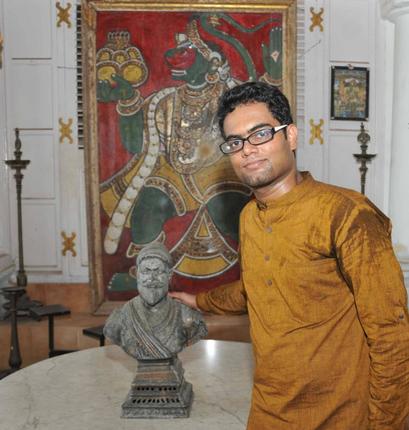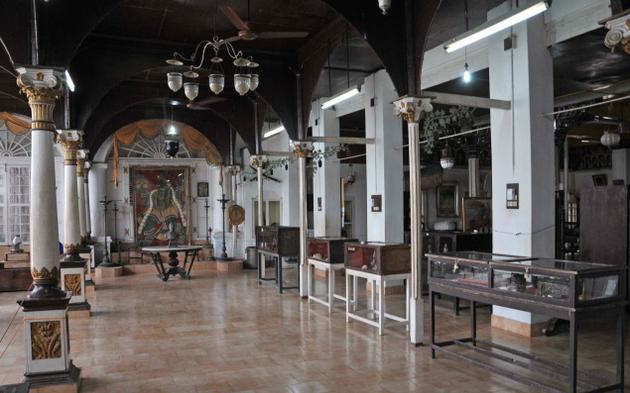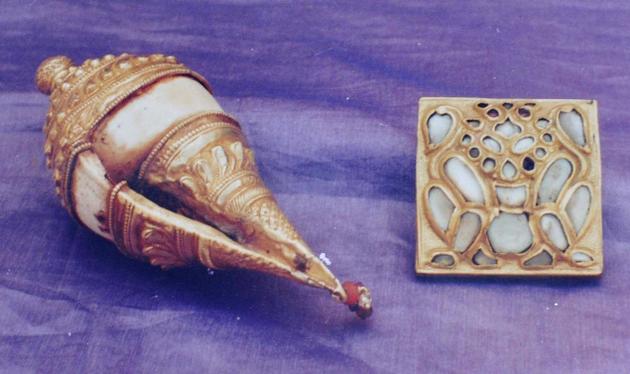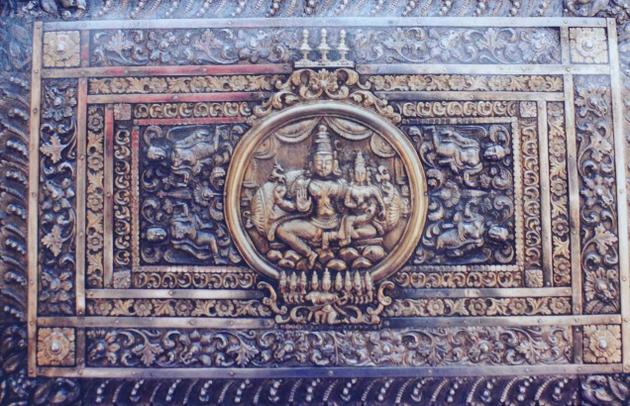
Pratap Sinha Rajebhosle, sixth descendant of Maharaja Serfoji II, has many ideas to create greater awareness about Thanjavur
The general cacophony of urban life recedes into the shadows at the centuries-old Sadar Mahal, part of the residential-cum-museum complex of the erstwhile royal family in Thanjavur. The faded grandeur and haphazard (government-funded) restoration cannot deflect visitors’ attention from what would have once been a master class in stucco wall detailing.
Showing some of us around on this hot afternoon is Pratap Sinha Rajebhosle, sixth descendant of Maharaja Serfoji II, who is convinced that the only way to promote Thanjavur’s heritage is “Facebook, Facebook, Facebook.”
The young prince, who also leads another life as a Bachelor of Technology student in Chennai, admits that his interest in his royal lineage is pretty recent.
“I used to come to Thanjavur during school holidays before, but for the past three years, I’ve become a regular visitor here. I am worried that very little of our heritage is left. That little bit has to be saved.”
His Facebook page on the Maharaja Serfoji Memorial Hall Museum (established in 1997) was also done on a whim, but the royal (who prefers to be known simply as Pratap), decided to keep it going after the interest it evoked from readers.
He refers to the city’s residents with the interesting Tamil-Marathi appellation “Thanjavur-kars”, and says many of the city’s expatriates from Singapore and Hong Kong got in touch after reading his online posts.
Pratap has also written a book on the contributions of the Thanjavur-Maratha kings with the help of scholars and rare documents, which is being readied for publication by the Saraswathi Mahal Library Museum, itself a treasure trove of rare documents.

Personal museum
The Maharaja Serfoji Memorial Hall Museum is located at the first floor of the Sadar Mahal palace. It is reached by climbing a dark stairwell of steep steps that leads off from a courtyard that is in urgent need of a lawn mower. Once known as the ‘anthapuram’, the courtyard used to house the private bathing pool of the royal women before the British decided to cover it up and re-lay it as a garden due to its weak foundation.

Exhibits in glass cases line the hall, whose cement-less walls are held up by wrought iron pillars.
The collection is a medley of what would have been considered novelties in those days – travel souvenirs and currency notes from around the world, pill boxes made of porcelain and crystal and a zinc-lined wooden ‘refrigerator’ that had to be cooled with external blocks of ice.

The more traditional artefacts include some of the personal effects of the royals – silk saris and turbans, huge utensils used during ‘bada khana’ (banquets) in the wood-fire fuelled kitchens, teakwood cupboards that once had silver beading in all the shelves and so on. Elaborately carved silver and wooden boxes to store the bath accessories of the queens are also on show.
Pratap points out to the more contemporary part of his family history in the collage of rare photographs down the ages. “The Thanjavur royal family has done a lot of public service, but among the more recent are the donation of hundred acres of land to the Bhoodan Movement of Vinobha Bhave. We also gave our weapons, two lakh rupees and 40 sovereigns of gold to the war effort during the Indo-China and Indo-Pakistan campaigns in the 1960s,” says Pratap.
The museum suffered a setback when it was burgled in April last year. As many as 14 articles, including lingams made of spatika (quartz) and maragatham (emerald), ivory idols of Krishna and old bronze knives were reported stolen in the daylight incident.
As a result, security has been stepped up, though it hasn’t stopped visitors from defacing the walls of the historic structure with crude etchings of their names and their proclamations of love.
Most of the glass cabinets have been sealed up, and the more precious artefacts (such as a gold dinner service used by the king), has been removed from public view.
No special treatment
Assimilating the ways of a life outside the royal cocoon has been an ongoing process from childhood says Pratap, who arrives for the interview on a decidedly plebeian two-wheeler.
“Our family has always believed in mingling with the public irrespective of social status,” he says. “In Chennai, we have more exposure, and my friends are pretty cool about my family history. I don’t expect special treatment from anyone.”
Most of the younger generation of the Thanjavur royal family has opted for graduate studies (most of Pratap’s cousins are engineers). Pratap has decided to supplement his regular course work with additional qualifications in document conservation and in the ancient Marathi language variant ‘Modi’.
“I will try my best to improve and preserve my family’s heritage,” he concludes.
https://www.facebook.com/serfojirajah2museum
http://maharajahserfoji2museumthanjavur.blogspot.in/
source: http://www.thehindu.com / The Hindu / Home> Features> Friday Review> History & Culture / Nahla Nainar / August 29th, 2014